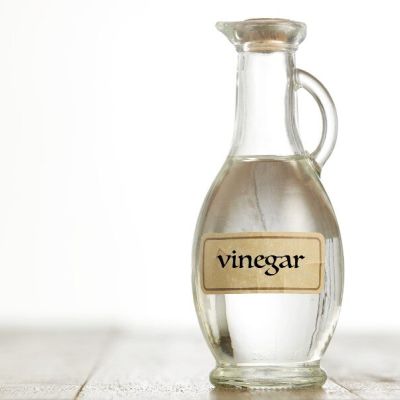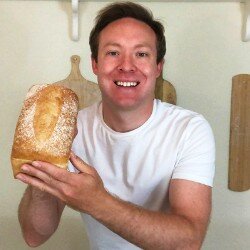
How To Use Vinegar For Baking Bread And Cakes?

Vinegar is most commonly known for its use in cooking and cleaning. But did you know it’s also an excellent ingredient for baking?
Let’s talk about it so you can learn how to use vinegar for baking bread or cakes in your next bake!
Vinegar can be a surprising addition to the arsenal of baking ingredients. However, it’s often found in baked goods because it reacts with baking soda.
What Is The Use Of Vinegar In Baking?
Vinegar is a mild acid that changes the pH levels of a batter.
Adding an acid to baking soda creates carbon dioxide bubbles when heated, which helps the batter rise in the oven.
It also helps break down starches and proteins in your flour.
Adding vinegar to bread dough enhances the loaf’s flavour, but it will also increase the rise and produce a moister crumb with an airy texture.
How Vinegar Improves The Rise Of Bread
Vinegar dissolves the chemical connections that hold protein threads together in a twisted state.
As the bonds dissolve, the gluten denatures, unravels and “tenderises.”
With repeated exposure, the unravelled gluten collides to create new bonds, forming the gluten matrix. These linkages coagulate the proteins and gradually re-form them into a more solid structure.
The air pockets created by the gluten matrix burst when the dough isn’t mixed and risen correctly.
Adding a little vinegar strengthens the gluten structure, making it especially helpful in short-kneaded or quickly-risen bread.
The acidity lowers the pH value of the dough, which provides a better environment for yeast fermentation. As yeast ferments faster, the proofing or rising time is accelerated.
How Vinegar Changes The Bread’s Crumb
Adding vinegar reduces oxidation in wheat flour.
Oxidation makes bread taste bitter, and the gluten to be less stretchy or extensible.
Including vinegar in bread improves the texture and feel of the crumb by enhancing the crumb structure.
When oxidation decreases, the dough can be kneaded and bulk-fermented for longer.
Developing a more extensible structure leads to better-handling qualities in the dough, a more significant rise and greater oven spring volume.
How Vinegar Improves The Flavour Of Bread
Vinegar is diluted acetic acid, an organic acid that appears naturally during yeast fermentation, which is a significant contributor to the dough fermentation process.
When bread is made quickly, a little bit of vinegar enhances the properties of the dough. The bread will appear as if a slow, more artisanal method was followed.
Acetic acid makes bread taste aromatic, produces a twangy, acidic flavour and lowers the pH value of the dough.
Does Vinegar Help Bread Stay Fresh?
A dough with added vinegar will have a better shelf life.
Lowering the pH value of the bread creates an environment that’s harder for bacteria and fungi to breed.
The acidic environment reduces the likelihood of mould developing.
Should I Add Vinegar To Bread?
Vinegar is an excellent ingredient for those wishing to make dough or bread.
A lot of vinegar kills the yeast when combined, but it’s okay to add small amounts without fear.
How much vinegar should I add to a bread recipe?
A teaspoon of vinegar per loaf is an excellent place to start. That’s around 5 grams per 500 grams of flour or 1% as a baker’s percentage.
Will Bread Taste Sour If I Add Vinegar?
Only if you add too much will the bread taste sour!
A single tablespoon of vinegar adds a mild, almost undetectable taste. It won’t wholly sour the dough.
In contrast, vinegar can create a more flavourful dough, as, like salt, it slows yeast activity.
Increased amounts of vinegar will make bread turn sour. However, most bakers prefer citric acid for this use.
Can I add vinegar to sourdough bread?
The lactic acid bacteria cultivated alongside wild yeasts in a sourdough starter can produce acetic acid. It’s, therefore, common to see vinegar added to sourdough bread sold in supermarkets.
The majority of supermarket sourdough bread contains yeast and conditioners to accelerate the rising time of the bread.
By shortening the fermentation stages, supermarket sourdough bread lacks flavour and acidity.
Vinegar is added to the recipe to compensate for the short fermentation period that properly-made sourdough typically enjoys.
What Do Baking Soda And Vinegar Do In Baking?
Adding vinegar with baking soda is ideal for raising many types of cakes. The combination creates a chemical reaction that releases carbon dioxide gas.
It makes the baked products rise in the oven and results in a fluffy, moist texture.
What Type of Vinegar should I use For Baking?
The most common type of vinegar for baking is plain white vinegar. It has a mild, uncomplicated flavour.
Another favourite is cider vinegar, made from fermenting apples. Cider vinegar has a slightly sweeter flavour than white vinegar.
Neither leaves an aftertaste behind when you use it in baked goods sparingly.
Balsamic vinegar adds an intense flavour that’s likely to overpower the beautiful taste of your bread. Steer clear!
For more information and vinegar choices, visit the best vinegar for baking.
Is It Necessary To Add Vinegar To Cake?
Yes! Adding vinegar to cakes can result in your cake being great!
With all the benefits that it can do to cakes, it should be necessary.
A dash of vinegar will make your cake moister.
Acidic ingredients cut through sweetness to leave a fresh, refreshing flavour.
What Can I Use If I Don’t Have Vinegar?
Lemon juice contains citric acid, which can be substituted for vinegar when baking.
If your recipe calls for one teaspoon of white vinegar, use ¾’s of freshly squeezed lemon juice. This ratio can retain your desired consistency.
Buttermilk can also be used in baking. As buttermilk is acidic, it reacts with baking soda and baking powder to increase leavening ability.
Can I Skip Adding Vinegar To A Cake Recipe?
Skipping vinegar from your recipe is unlikely to work out well.
While the flavour of your cake will surely be similar if you skip it, the texture, lightness, and tenderness will not be present.
So, it’s best to use vinegar if the recipe says so.
How Much Vinegar Do I Substitute For An Egg?
Vinegar is a natural leaven for a cake if you don’t want to use eggs. It works well as an egg substitute in cake, cupcake, and muffin recipes.
Vinegar doesn’t contain protein or fat but will improve the structure and rise, just as an egg would.
Mix one teaspoon baking soda and one tablespoon of vinegar to replace one whole egg.
If your recipe calls for two or more eggs, adjust the amount of baking soda and vinegar with the same ratio.
If you’ve enjoyed this article and wish to treat me to a coffee, you can by following the link below – Thanks x

Hi, I’m Gareth Busby, a baking coach, head baker and bread-baking fanatic! My aim is to use science, techniques and 15 years of baking experience to help you become a better baker.
Table of Contents
- What Is The Use Of Vinegar In Baking?
- How Vinegar Improves The Rise Of Bread
- How Vinegar Changes The Bread’s Crumb
- How Vinegar Improves The Flavour Of Bread
- Does Vinegar Help Bread Stay Fresh?
- Should I Add Vinegar To Bread?
- How much vinegar should I add to a bread recipe?
- Will Bread Taste Sour If I Add Vinegar?
- Can I add vinegar to sourdough bread?
- What Do Baking Soda And Vinegar Do In Baking?
- What Type of Vinegar should I use For Baking?
- Is It Necessary To Add Vinegar To Cake?
- What Can I Use If I Don’t Have Vinegar?
- Can I Skip Adding Vinegar To A Cake Recipe?
- How Much Vinegar Do I Substitute For An Egg?
Related Recipes
Related Articles
Keep up to date with the latest Articles, Recipes & Bread Baking info by joining my mailing list
Join The Weekly Bread Baker's Newsletter!
Latest Articles
Baking Categories
Disclaimer
Address
8 Woodland Avenue,
Worthing
West Sussex
BN13 3AF
UK







